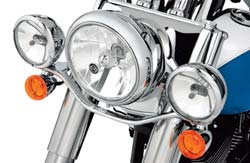


Medical research shows hexavalent chromium perforates nasal passages, rashes the skin, and causes other medical conditions, some severe. But the argument over chrome puts metal finishers in a difficult, if not impossible, position. Chromium is a crucial element in the industry—according to some estimates, 90% of all metal finishing is done with either chrome or zinc. Hexavalent chromium is sometimes referred to as the metal finishing industry's "workhorse." Yet at the same time, metal finishers battle to remain competitive against offshore finishers operating under substantially less lax environmental regulations than finishers must meet in the United States. Thus, the search for effective, practical alternatives to chromium is gaining momentum.
It's gaining urgency, too. Last October, OSHA, the Occupational Safety and Health Administration, proposed to tighten the standard for hexavalent chromium exposure at the job from 52 µg/m3 to 1 µg/m3, far stricter than the exposure levels enforced in competitor nations—not just China and India—but even in Canada, where the regulation remains at the 50 µg/m3 level. Yet OSHA believes the proposal is both for the public good and practical for the industry.
"The risks involved in the occupational use of hexavalent chromium can be serious and potentially life-threatening. This proposed rule is both economically and technologically feasible and will substantially reduce the risk to workers potentially exposed to hexavalent chromium," stated OSHA Administrator John Henshaw in a press release.
Though its impact on U.S. metal finishing could be enormous, the proposal came as no surprise to anyone in the industry. It follows years of litigation and negotiation with the metal finishing industry, unions, and watchdog groups like Public Citizen. It is, in fact, mandated by an order issued by the U.S. Court of Appeals for the Third Circuit in 2002 in the aftermath of a lawsuit filed by Public Citizen and the Paper, Allied-Industry, Chemical, and Energy workers international union (PACE).
After the OSHA announcement, the National Association of Metal Finishers (NAMF) immediately protested. The proposal will pose "substantial technical and economic feasibility challenges for companies attempting to comply with such extremely low limits," the association stated in a release.
Based on initial industry estimates, finishing operations may have to spend up to $300,000 per year to meet the new standard. This could force many companies to either install expensive control measures above and beyond those that are currently in place to protect worker health, or abandon hexavalent chromium finishing operations.
The Policy Group in Washington, NAMF's and the industry's regulatory and government affairs organization, believes the data supporting OSHA's proposed limit is outdated at best and inaccurate at worst, and that the agency has not established a clear correlation between hexavalent chromium use by metal finishers and cancer deaths caused by exposure to the substance at levels substantially higher than what is being proposed. Moreover, some of the data OSHA seems to be relying on are as much as 50 years old, critics have pointed out.
While metal finishers are naturally concerned about the proposal, they're just as worried about whether any viable, practical alternatives to hexavalent chromium truly exist. "Atotech, which is the world's largest supplier of hexavalent chromium, has been looking for several years for a substitute," said Bill Saas, president of Taskem Inc., an industry supplier. "They haven't found one."
He added: "I don't think there's going to be a home run in this hunt, but I do believe there will be some extra-base hits. Rather than coming up with a single environmentally acceptable alternative for all uses of chromium, suppliers are coming up with several alternatives for several applications."
"There are alternatives out there for both hard chrome and decorative chrome finishes, but they all have advantages and disadvantages," said Marc LeBaron, president of Lincoln Plating (Lincoln, Neb.). One of his company's chief customers is Harley Davidson. Lincoln finishes much of the chrome work on the company's famous motorcycles; it also excels at high-volume but technically complex finishing jobs, many of them involving hexavalent chrome. "Most of the alternatives I've seen are not acceptable for high-quality work."
"The question all of us in the industry who use chrome have to ask is, ‘What's the cost of an alternative to the customer, and is it worth it?’ This is the kind of question I don't think OSHA ever asks, but it's what we have to live with,” LeBaron added. “An alternative, even one that is environmentally acceptable, won't do anyone any good if it's too expensive or too difficult to use, or just doesn't do the job."
Among the available alternatives to hexavalent chromium, trivalent chromium appears to hold the most promise. According to one manufacturer, Enthone, trivalent chrome "provides a safter and environmentally acceptable alternative…It decreases health hazards from airborne chromium. Waste treatment and disposal costs are reduced because the process uses no hexavalent chromium, no additives with strong oxidants, and has an extremely low metal concentration—75% lower than ammonium chloride trivalent chromium systems, and up to 95% lower than hexavalent chromium." Enthone said its Trilyte product "is a sulfate-based system which deposits a bright finish virtually indistinguishable from hexavalent chrome."
Suppliers of trivalent chromium aren't the materials' only advocates. The Board of Public Works for the city of Los Angeles is also a supporter, touting the benefits in a fact sheet. "Trivalent systems can save an electroplating shop money in a number of ways," stated the board. They include lower metal concentrations and current density, and reduced dragout, fumes, and liability. "By installing a trivalent system, you avoid the need to reduce hexavalent chromium wastes to their trivalent state. Since three pounds of sodium met bisulfate are required to reduce each pound of chromic acid, significant quantities of chemicals, as well as equipment and labor costs, are eliminated by switching to a trivalent system," the board advised.
At the same time, trivalent chromium systems are associated with certain color problems, notably darkness and a noticeable lack of shininess—critical factors for decorative chrome work. The chemical cost for a trivalent system is also higher than for a hexavalent system. Plating time and temperature required per part are higher, too, with trivalent.
In Germany, the Propper Co., a metal finishing supplier of automotive components to OEMs, challenged its chemical suppliers to develop new non-hexavalent chemistries. Propper had been spurred in this effort by Renault, the big French automotive manufacturer; since 1997, Propper has been a key electroplating and coating supplier to Renault. The result of the challenge was the installation of a new plating system in a 16,000-square-foot addition to Propper's plant in Langenfeld, Germany, featuring automated barrel electroplating integrated with a centrifuge coating and drying system.
The installation reduces water needs compared to the hexavalent chromium system it replaced, and it requires fewer chemicals and personnel to function. It is believed to be the largest integrated barrel electroplating and centrifuge coating facility able to make the claim that no cyanide or hexavalent chromium are used.
Propper's line, featuring centrifuges capable of tilting at various angles and spinning of infinitely variable speeds, results in the reduction of dragout of chemicals and rinse water by as much as 95% compared to conventional automated barrel or manual chromate systems, processes transparent and black chromate finishes for zinc nickel, yellow and black chromates for zinc iron, blue and yellow chromates for acid zinc, pre- and post-treatment for zinc nickel and zinc iron, and activation for alkaline and acid zinc. A single worker can operate the entire system.
But such a system requires an investment that's beyond the means of many, if not most, small- and mid-volume U.S. job shops without big automotive accounts. Propper has more than 100 customers, about 85% of which supply products for high-volume industries, including auto manufacture and construction. Some job shops here continue to hope against hope for the best outcome of the debate over the OSHA proposal.
OSHA will get sued no matter where they finally set the standard," LeBaron observed. "If it's too high, they'll hear from labor and the environmentalists. If it's too low, they'll hear from the industry.
The 1 µg/m3 level they're talking about, if you look at the evidence and data, they don't support that level. "So I think it's like an opening auction bid," he added. “The final number will be different."
While it waits for the eventual outcome, the industry may find itself on the side of the government, actually—on the side of at least a part of the federal government, that is. The Department of Defense (DOD) is a huge consumer of metal finished parts, and it is also a major metal finisher in its own right. OSHA's limit could prove to be cost-prohibitive for DOD, putting the department's interests in line with the industry's. Ironically, experts say the federal government lobbying against itself could prove to be just the distraction that leads to a final rule the industry can live with.





